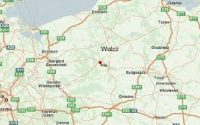At Europe’s Core: Part 2 – Budapest
05.03.2019
Vienna Hauptbahnhof. The Austrian trains are all sleek and polished and as with the German and Polish railways, information is well organised, down to the location of your carriage on a diagram. I glance out of interest at the Arrivals and Departures board and note the consistency in the train numbers bound for Salzburg, Linz, Innsbruck, Munich and Zurich etc and note that my train to Budapest – final destination Cluj-Napoca in Romania has a number whose letters are not consistent with these other places. What turns up on Platform 10 is an old blue and yellow Hungarian or maybe Romanian bucket and I think – ah well that’s what adds to adventure – the unexpected.
Thankfully the unexpected does not include a late arrival, in fact it’s on time to the exact minute and I set foot for the first time in Hungary (the Hungarians name their country Magyarország and the people are Magyárs) . My recent ancestry on my paternal grandmother’s side is, as I’ve said before, Hungarian and to recap I understand they, being of the Protestant faith, had to leave Hungary and seek refuge in Poland on account of the Counter-Reformation activities in Austrian-ruled lands. And so I arrive at Keletai Station Budapest.
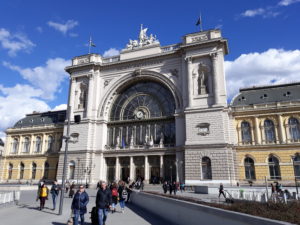
Jokai Tér where I am based is not far from the centre of the city and just off the fashionable Andrássy Street along which stands one notorious building at Number 60 but more of that later. The building is redolent of the hotels built in the 1970’s and at first I am unimpressed with the exterior until I learn that it is a listed building used as an example of ‘communist architecture’. Inside is a complete transformation with a pleasing décor. Renovation continues in the hotel but it is discreet and out of the way of the guests.
The style of the city is not dissimilar to Vienna; grand buildings but mostly without the imperial trappings. Both cities have almost identical populations.
As it is early afternoon, what better than catch a first glimpse of the city and collect my travel and attractions pass. As with all major European cities, Budapest too has what seems a regular and efficient public transport system; buses, tramcars, trolley buses and a metro. The Danube here is much wider than Vienna obviously as it is further down in the direction of it’s destination at the Black Sea. Whilst on the Elizabeth Bridge (in memory of Emperor Franz Josef’s wife, Sisi as she was fondly remembered here in Hungary) I receive a text from Louise to say that her daughter, my fourth granddaughter has been born. She hasn’t chosen a name and so I text back and suggest Elizabeth which I really think is a long-shot! I’ll plan my itinerary which will begin tomorrow with the free walking tour of the city – Pest in the morning and Buda in the afternoon.

06.03.2019
Budapest Walking Tour (free of course) begins at 10.00 from Váci Street and the metro is three stops away. I’ve been used to the metro systems in London, Paris, Vienna, Berlin and Warsaw which are all sleek and polished. What a difference this one in Budapest is. This is Metro Line 1 and it is a UNESCO world heritage site as it was the first electrified underground transport system in mainland Europe. The other three lines have a more modern décor. The station names are all an art nouveau style and ceramic brick walls and the platforms are very short compared to the long lines in these other ones, which means the trains are only three carriages long. However, more importantly, they run on time. The system reminds me of the old Glasgow Metro. It looks fun and it’s good to see a bit of retro now and again.
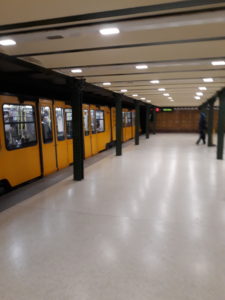
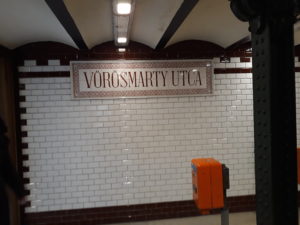
We’re walking on the Pest side this morning and Buda in the afternoon. Pest is the commercial and banking side and the place abounds with entertainment venues and restaurants of every variety as you expect in a capital city. I’m more interested in Hungarian cuisine though. The guide explains that the Danube was the border of the Roman Empire and there are glass casings displaying the lines of old buildings from that period. Across the river from Pest was ‘barbarian’ country as the Romans would have described. The magnificent basilica, dedicated to St. Stephen who was the first Christian King of the Magyárs, dominates the surroundings. One of my boyhood footballing heroes, Ferenc Puskás, is buried here. Is it a coincidence that the main cathedral of Vienna is also dedicated to St. Stephen? Not really, as the Vienna cathedral, dating from 1137, eclectic in style, is dedicated to St. Stephen the first recorded Christian martyr. Construction of the Budapest cathedral began in the early 19th century is Neoclassical in style with the interior Baroque decoration. Parliament Building sits on the banks of the river and again it’s square dominates the surroundings. The guide tells us that anyone can sit and listen to the debates but it seems, like Britain, left and right hurl insults at each other for points scoring. Democracy isn’t meant to look like this. Budapest’s civic buildings, the National Theatre, The Opera House and so on are built on the same grand scale as those in Vienna. A controversial new memorial to the Holocaust is under construction in Szabadság Tér, located midway between the Parliament Building and St. Stephen’s Basilica. Articles belonging to the victims are displayed but this time I avoid looking as I have seen all I need to see of the Holocaust. What I saw at Auschwitz, the Memorial Building in Berlin and culminating at Yad Vashem in Jerusalem will always be with me. The latter is the definitive memorial. Not far from the memorial in Liberty Square stands a memorial and burial place of the USSR Red Army soldiers who died in the Battle of Budapest. Every soldiers name is inscribed on it. Not far from the memorial stands a sculpture to Ronald Reagan depicted as walking to the American Embassy but keeping his eye on the Red Army Memorial. It’s said that if you shake the statue’s hand it will bring you luck. No, I cannot bring myself to shake Reagan’s hand!

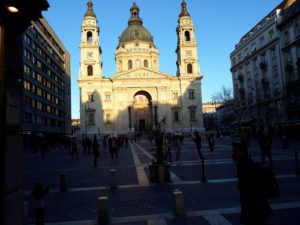


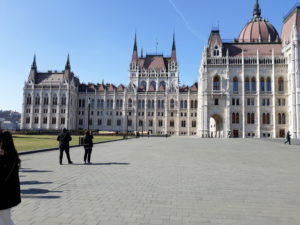
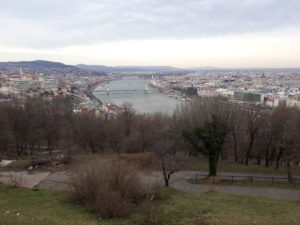
I had no idea that the Romans came as far as the south side of the Danube and settled in Pest. I know of the Mongol invasions and of periodic occupation by the Ottoman Turks who menaced this area of Central Europe as well as Southern. That said, until their conversion to Christianity and acceptance into Christian Europe, the Magyárs themselves were a constant threat to their neighbours. On the subject of the Ottoman Turks, have you ever heard of a Hungarian wine called ‘Bulls Blood’? It was a popular sell in the 1970’s and ’80’s. The label told the story behind the wine’s name. In the year 1552, a Hungarian general named István Dobó successfully defended the Hungarian fortress city of Eger from the marauding hordes of the Ottoman Empire. So fierce was the resistance of the defenders that the Ottomans thought they drank bulls blood for courage. Still on the topic of wine; my father once told me that the best wine he ever drank was ‘Tokaj’ whilst he was in Hungary in autumn 1939. With this memory, I entered a shop and asked for a bottle of Tokaj wine at which point the shopkeeper looked at me said ‘certainly sir’ and pointed to the choice of many brands of Tokaj on display and asked ‘which one would you like?’ Stumped – but he talked me through the labels and I settled for a couple of bottles of ‘Dry Furmint’. Whether or not my father tried this one, I’ll give it a go.
Buda is completely different from Pest. This was the seat of government during the Mongol invasions as it is set on a hill, to which the Magyárs had to retreat to better fortified positions. Budapest Castle is an imposing structure, dominating that entire side of the river. The climb up should be tackled, especially the steps leading up to the Jesuit Chapel, as a means of taking off the extra kilos from the delicious Hungarian cuisine. Everywhere the interconnection with Austria is evident even though tensions spilled over in the Hungarian Wars of Independence. In the end the Austrians as usual steeled matters in their pragmatic way and called the empire the Austro-Hungarian Empire, thus avoiding further violence for a time. But tensions still simmered among the other nationalities; Poles, Czechs, Slovaks, Romanians, Ruthenians, Croats and so on, paving the way for the border disputes that plagued Europe between the World Wars. Diplomats from other countries such as French and British simply cannot resolve matters with a map and a red pen.
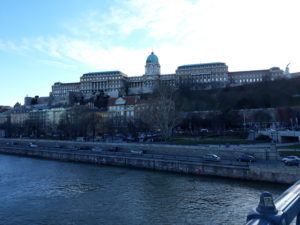
From what I have observed, the mistrust Central Europeans have for people of the Islamic faith is not recent and stretches back centuries, boiling over from time to time such as happened in the former Yugoslavia in the 1990’s. How long before Central Europeans stop looking upon all Muslims as a Trojan Horse? The populist movements there are exporting this ideology to the western part of Europe and the exploitative elements in the west see the Muslim migrants as a source of cheap labour and all the while the bureaucrats in Brussels push for more European integration – now. This is far too hasty and can only foment imaginary threats from migrants conjured up by nefarious elements in the media. It results in radicalisation of both native and migrant. That said positive action by the European Union is the only solution. The Muslim migrant has to feel European and it will never be achieved through cultural ghettoism.
After this long digression, back to the tour and this side of the city abounds with history even though it has a small town air about it after the bustle of Pest. This incidentally is the residence of the Head of State.
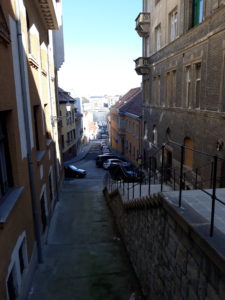
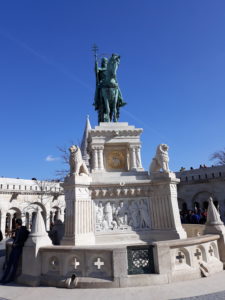
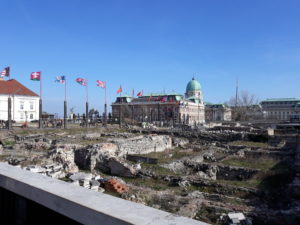

I’ll come back here tomorrow to the castle and view the 3D film of the history of Hungary, visit Gellért Hill and the citadel, where my father was detained in 1939, whilst making his way from occupied Poland to France. After all it is small part of family history.
The Central Café, back on the Pest side is a classic coffee house but unlike Vienna, neither Lenin nor Trotsky plotted there – I asked. I’d also like to visit the Lutheran museum as Lutheranism seems to figure in my ancestry.
07.03.2019
In Britain, bar the invasions of countries and the Jewish tragedy, very little is known about events in Central Europe between 1939-45 and after, during the early years of communism especially the Stalinist version. The Terror House, a museum at 60 Andrássy Street is about to change that and by the end of the tour I realise that compared to what happened in Hungary the DDR’s STASI were like Sunday School teachers. During WW2 there was the fascist right wing Arrow Cross led by Ferenc Szalási which came to power in Hungary in 1944. This was a murderous organisation which collaborated completely with the Nazis and was responsible for, among many other crimes, the murder of over 10,000 Jewish citizens in a six week period. After the end of WW2 when the Communists took power a dedicated Stalinist Mátyás Rákosi terrorised the population using the same methods as the Arrow Cross. In fact the Arrow Cross simply swapped fascist uniforms for communist ones and continued their killing as the AVO, the title of the Hungarian Secret Police.
The ‘liberation’ of Hungary by the Red Army resulted in 700,000 Hungarians being forcibly deported to the USSR as slave labour. Stalin’s revenge on Hungary resulted in 200,000 deaths. After Rákosi became de facto leader of the Hungarian Communist Party and took over power in 1949, and wishing to be seen as Stalin’s ‘best pupil’ he created a Reign of Terror which resulted in thousands of deaths and wholesale imprisonment. Aided and abetted by Russian advisors, the purges escalated everywhere to such an extent that even loyal Communist Party members and members of the Secret Police (AVO) and State Security (AVH) were purged.
In this building, the imprisonment, torture, murder and execution of political prisoners was perpetrated. The gruesome basement cells still smell of urine and excrement. For many years this went on as prisoners were denied any cleaning materials. It is one of the most horrific places I have ever visited. Much of this terror precipitated the Hungarian Revolution of 1956, which was subsequently put down by forces loyal to the Party with the aid of the USSR. Therefore from 1944 up until the mid 1960’s, when moderate reforms were made to the economy and security became less severe, Hungary was more or less a vast prison, the jails full and the populace not knowing when their luck was at an end with ‘the knock on the door’ in the middle of the night. The citizens of all the old ‘Iron Curtain’ bloc know the value of freedom and Hungary is the perfect example of how far right and far left, poles apart in ideology, are essentially the same in the methods they use to enforce those ideologies and don’t discriminate on the class of thug they employ. I left the museum stunned.
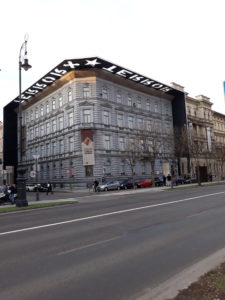
A walk up to the Citadel in Buda in the afternoon for no other reason than it was where my father and other Poles fleeing from both the Nazis and the Red Army, were detained in 1939. Hungary was an Axis power but with historical alliances to Poland. The authorities paid lip service to the Nazi requests to detain Poles. My father told me that with the collusion of the Hungarian guards, they all escaped from the Citadel one night and were given assistance to escape on to Yugoslavia.

Right now I’m wondering if my father had returned to Poland after WW2, would he have survived the purges that took place in Poland in the 1950’s? I don’t know if the Polish Stalinist regime then was as severe as that in Hungary. I know that Poles who were repatriated from Britain after the war were often treated as criminals and were imprisoned, sent to labour camps and in some cases executed. Was there resentment from Poles who had survived the Nazi occupation to the repatriated? Both of my grandparents were repatriated but Edward had been a POW in Germany and Joanna a detainee in Siberia, eventually being freed under The Amnesty from Stalin to the detained Poles. My father might have been worse off than both. People might ask how could anyone shut off their family. This never happens deliberately. I never knew my father say anything of his feelings towards that. My mother once said that he would have left Poland even if there had been no war. I believe that only to be part of the story made for her consumption by my father. I believe he kept everything filed away in the deepest vaults of his memory. That is a hard thing to imagine. None of us who have not had that experience can comprehend how it affects the person. This is what ideology and its blind pursuit can destroy. In my own simplistic way I’ve been affected by it. For me no extended family from both paternal grandparents’ sides.
Before making this trip, I sent away DNA samples in the hope of finding any unknown relatives on my father’s side. I’ve heard people say what if they turn out to be bad characters? That misses the point because for me it would not matter. There would be decent characters too. Any confirmation that they exist would be sufficient.
08.03.2019
Spending the morning in the much quieter Buda. The tour guide gave us some pointers so now I’ll check out a few things. The 3D exhibition that gives a whistle-stop tour of Hungarian history is a snapshot of seemingly endless violence, not too dissimilar to Poland’s but maybe more so -the usual intrigue, shifting alliances, invasion, occupation and endless burning. I decide to spend most of the day in Buda which is much quieter that Pest and I think this is something that attracts me to this city. There are spaces outside without any surrounding noise. The Mary Magdalene tower is the only part of a 14th century church, which was destroyed by bombing or bombardment during WW2 and which the Hungarian authorities refused to restore. I understand that there are now plans to carry out the work at some future date. In a strange way a ruin tells a deeper story that an original still in place. I thought it might be an idea to look in the archives building but today is Friday and it is closed.





When you see Budapest today it is difficult to imagine what it was like 70 years ago; a terrorised populace living in a ruin, with the economy and standard of living dragged down in the name of Stalinist orthodoxy – destroyed – and this is not a poor country. Why can’t politicians just maintain standards of living and freedoms instead of embarking on economic experiments (far right equally as bad as far left). Now I’ve got that rant out of the way I reckon I should check out a ruin bar later, for which Budapest has become world famous. To really set the scene for excellent food you’d expect to find a Budapest restaurant with a name along the lines of ‘The Fighting Hussar’ or ‘The Noble Plainsman’ but I’m having to settle for the ‘Hungarian Kitchen’ (the food here is wonderful)which serves rabbit thigh, dumplings and mushrooms followed by Gerbeauad cake, (Zserbó szelet) a signature Hungarian dessert.
Ruin bars; now is the time to sample: Szimpla Kert has received much positive publicity (the rest very close behind). Situated in Budapest VIII District in the old Jewish Quarter (which is undergoing a revival) this is less of a bar and more of a drinking forum with about ten individual bars contained in the one building. It is quite literally what it says a drinking place in a ruined building, but it’s adventurously lit in a variety of individual styles and the roof a wide range of, let’s say, ‘spontaneous’ materials. A great place to socialise and there was no music coming out of the walls (not early evening anyway). A terrific experience and at the equivalent of £2.50 for a 0.5 litre measure, what’s not to like! Back tomorrow.


09.03.2019.
A walk through the Jewish Quarter and a relief map delineating the extent of the Budapest Ghetto, which I have photographed made, I think, of copper, is attached to one of the walls of a synagogue. The ghettos in Warsaw and Łódź in Poland are widely known but this one, for whatever reason is less so even though the events here during WW2 were just as horrific and happened over a period of six weeks. Perhaps it’s because of that and unlike the Polish ones which were established in 1939 as a marshalling point for Austrian, German and Polish citizens of the Jewish faith while the Nazis pondered a final solution. Established, as I already knew from the House of terror Museum, when the Arrow Cross Party took power in 1944, between December 1944 and January 1945, 10,000 Hungarians of the Jewish faith perished here. A final total of 600,000 or 23% of the population of Hungary died in the Shoah(Holocaust). On the wall of the synagogue superimposed on the copper map are spy holes behind which 3D black and white images depicting life in the Jewish Quarter before the Shoah. It reminds me of what I saw at Yad Vashem in Jerusalem. Repeating myself, 75 years later anti-semitism breathes again and is gradually becoming the norm. Politicians again using the media, not only as an organ of anti-semitic rhetoric but anything else that doesn’t fit in with their narrow xenophobic, bigoted agenda.
This latest tour lasting ten days has cemented my conviction that I’m a true continental European – who happens to enjoy a good Scottish pipe band, Polish pierogi, German white beer with raspberry syrup and Italian Pinot Grigio (Venezia) among many other things. It is simultaneously a sobering as well as exhilarating thought that less than one hundred years ago my forebears strolled around the streets in Austria and Hungary as well as Poland and Germany I wonder what the DNA test results I await will reveal?
Hungary always seems to be thought of as a Roman Catholic country, and the census’ appear to confirm Catholics are in the majority; but that is without an understanding that the Reformation was successful here until the Counter Reformation. Many had become Lutheran or Calvinist and there is a plaque in Buda Castle which commemorates the 500th anniversary of the Reformation in 1517. The Counter-Reformation would explain why it seems that my forebears fled to Poland, which while still being predominantly Catholic did not participate in the persecution of a single Protestant. Perhaps the reason for the perception of Hungary being a devoutly Catholic country is the resistance to Nazi and Communist rule displayed by Cardinal József Mindszenty in the 1940’s and 50’s. Just one last thing; I was unable to visit any of the famous Budapest spa baths. This treat will be for the future.
10.03.2019.
We are sardines in a can on the densely packed 100E Airport bus to Ferenc Liszt Airport which is smaller than I imagined it would be. I think Dublin Airport is bigger. The last ten days here, as I have already said have cemented my cultural and genetic affinity with Central Europe. I have learned so much more from seeing history displayed and how many of the pieces are equated with my family history. Having a connection with a place helps visualise how they might have lived. I think my great-grandfather’s side of the family may originally have settled in Hungary from Armenia. It’s a theory I intend to test some time in the near future. From a reading of the history of the region and the movement of peoples a strong possibility exists. For now it’s time to return home and muse over it all.
Ends

